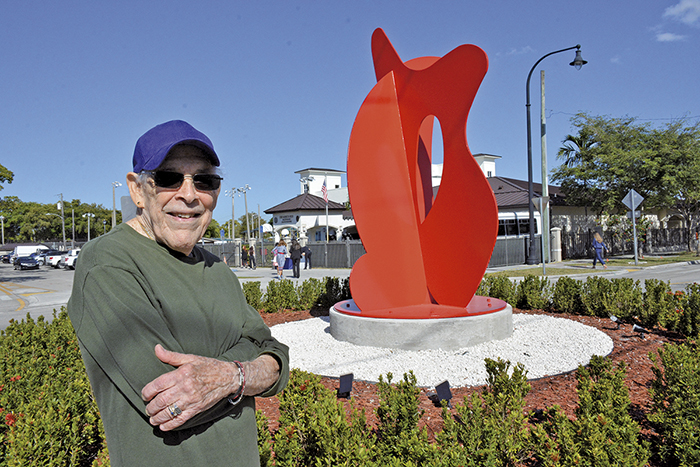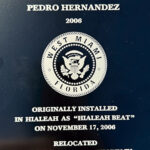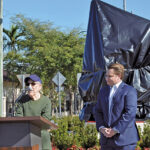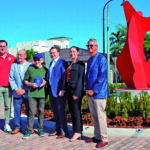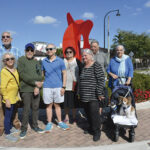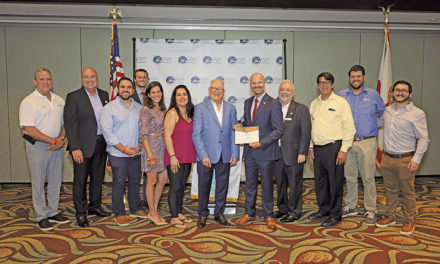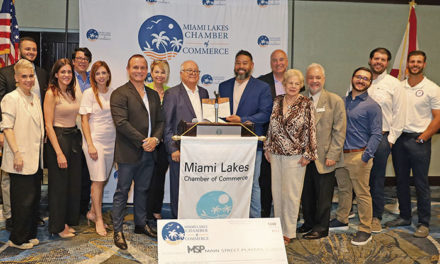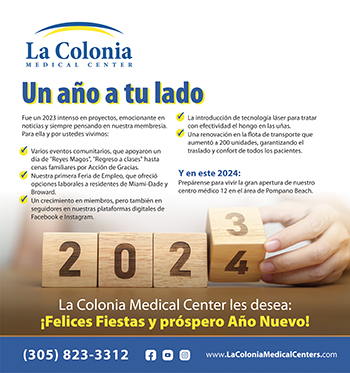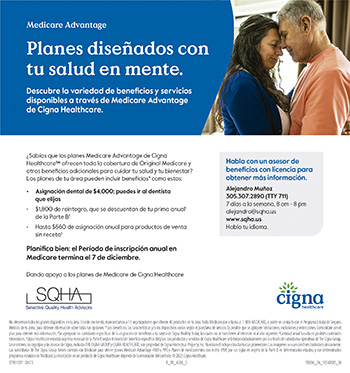By Jesús Hernández
Art is an essential resource for sociocultural evolution, and sculptor Pedro Hernández Domínguez and the City of West Miami are joining ideas and resources to foster artistic expressions with the installation of an extraordinary sculpture and a promising public art program.
Pedro Hernández Domínguez, a renowned Cuban artist and a resident of this Miami-Dade municipality for several decades, whose works have been displayed in major exhibitions or are part of important collections, welcomes one of his pieces on the city’s streets.
In fact, the piece, renamed The Beat of West Miami, was conceived to be displayed in Hialeah, where it remained for several years. An agreement between both cities allowed the sculpture to be moved to West Miami.
«It’s a tremendous honor to have it here, in West Miami, because this is where I’ve lived for many years. We raised our children here, and they grew up here,» the artist acknowledged.
The piece, made of iron and signified by red, captures the abstract interpretation of movement, be it a body, the wind, or even the rhythm of the city, without needing to represent specific objects.
«Everyone asks me what this sculpture means. Some people see a sailboat, others see a mulatto woman because of the curves. But I try to explain that art is the result of a state of mind, and that’s what I try to represent, with curves and movements,» the sculptor explained.
Hernández Domínguez began his artistic career in Cuba in the 1950s and experienced the fervor of the Cuban avant-garde school, where he met greats artists such as Víctor Manuel, Amelia Peláez, and José Mijares.
Today, his pieces are part of the permanent collections of the National Museum of Fine Arts in Havana, the Museum of Geometric and MADI Art, and the Miami-Dade Public Library System.
Outside the canons of visual art in Cuba, Hernández Domínguez found his artistic inspiration in abstraction.
“I broke with traditional figurative sculpture,” he emphasized.
Nowadays art confronts the new realities of society, from vested interests, economic and even ideological limitations, to lack of freedom to create in some cases.
“But art continues. People believe in art, and art will always endure,” he emphasized.
City of West Miami is putting in place Ordinance # 2024-12, relating to art in public places, “to promote the general welfare by encouraging pride in the community, increasing property values, enhancing the quality of life through artistic opportunities, uniting the community through shared cultural experiences, and creating a cultural legacy for future generations through the collection and exhibition of high-quality art pieces that reflect diverse styles, chronicling history through the collection of artifacts, documents and memorabilia that will acknowledge the past and create programs and activities that will further these goals”.
West Miami Mayor Eric-Diaz Padron commented:
“Number one was obviously this first sister city agreement with Hialeah to bring back this piece to our city, which is the first one in a very prominent location in the heartbeat of our city, which is our recreation center.”
“It was a donation from Hialeah as part of a greater partnership. And we’re extremely grateful. I’m extremely grateful to Mayor Esteban Bovo, Jr. I’m extremely grateful to the City of Hialeah, our strong partners,” he affirmed.
During the public presentation, Mayor Diaz Padron said: “We focus on safe streets, we focus on clean streets, and now in this term we’re adding a new focus of beautiful streets, and this sculpture is going to be the first of many public art pieces and installations that will go throughout the city. It’s an effort to make our city more beautiful, more vibrant, making sure that whenever you go through our city you know that it’s the gem that it is in the county, and that everyone can see it and everyone can enjoy it.”
Later, the mayor pointed out: “The next thing we’re doing is providing city spaces and allow local artists to come in and make them studios and spaces to cultivate art in our community.”
Also, West Miami has created an arts and public places board and a new ordinance that will allow for percentages of the building cost for developments to go into public arts for those developments.
“Every time a new building goes up in the city of West Miami, there will be an additional public art piece in the city of West Miami,” he emphasized.
“We’re cultivating international relations to see if we can even cultivate art from artists who want to be located here in the City of West Miami in the heartbeat of Miami-Dade County”, Mayor Diaz Padron announced, as he anticipated “we’re going to be hitting every stone and making sure it’s there’s no stone unturned to make sure that our streets are beautiful, that they’re vibrant and that they really cultivate arts in our community and in our in our part with our partners”.
At the same time, the City of West Miami collaborates closely with partners to be cost effective. “I would put us next to any city in terms of protecting our taxpayers, making sure that we are providing the essential services to our city that taxpayers are expecting.”
El arte se hace público en West Miami
El arte es un recurso esencial para el desarrollo de la sociedad y el escultor Pedro Hernández Domínguez y la alcaldía de West Miami juntan ideas y recursos para fomentar la expresión artística con el emplazamiento de una extraordinaria pieza escultórica y un prometedor programa público.
Pedro Hernández Domínguez, reconocido artista cubano de larga data y vecino de la localidad miamense por varias décadas, cuyas obras han sido expuestas en importantes exhibiciones o forman parte de relevantes colecciones, ve con regocijo la presencia de una de sus piezas en las calles de la ciudad.
De hecho, la pieza, rebautizada The Beat of West Miami, fue concebida para ser expuesta en Hialeah, donde perduró por varios años. Un acuerdo entre ambas alcaldías permitió que la representación escultórica fuese trasladada a West Miami.
“Es un honor enorme tenerla aquí, en West Miami, porque aquí es donde he vivido por muchos años. Aquí criamos a nuestros hijos y aquí crecieron”, reconoció el artista.
La pieza, hecha de hierro y significada en color rojo, recoge la interpretación abstracta del movimiento, sea un cuerpo, el viento o incluso el ritmo de la ciudad, sin necesidad de representar objetos.
“Todo el mundo me pregunta qué significa esta escultura. Unos ven un barco de vela, otros ven una mulata porque tiene curvas. Pero yo trato de explicar que el arte es fruto del estado de ánimo, y eso trato de representar, con curvas, movimientos”, puntualizó el escultor.
Hernández Domínguez comenzó su carrera artística en Cuba en los años 1950 y vivió parte de la ebullición de la vanguardia de la escuela cubana, donde conoció a grandes artistas como Víctor Manuel, Amelia Peláez y Jose Maria Mijares. Hoy sus piezas forman parte de las colecciones permanentes del Museo Nacional de Bellas Artes de La Habana, el Museum of Geometric and MADI Art, y la red de Bibliotecas Públicas de Miami-Dade.
Al margen de los cánones del arte plástico en Cuba, Hernández Domínguez encontró su inspiración artística en la abstracción. “Rompí con la escultura tradicional figurativa”, subrayó.
Hoy el arte enfrenta las nuevas realidades de la sociedad, desde intereses creados, limitaciones económicas e incluso términos ideológicos hasta la falta de libertad para crear en algunos casos.
“Pero el arte sigue. La gente cree en el arte y el arte siempre resistirá”, recalcó.
Por otra parte, la Ciudad de West Miami implementa la Ordenanza 2024-12, relacionada con el arte en espacios públicos, “para promover el bienestar general fomentando el orgullo comunitario, incrementando el valor de las propiedades, mejorando la calidad de vida a través de oportunidades artísticas, uniendo a la comunidad mediante experiencias culturales compartidas y creando un legado cultural para las generaciones futuras mediante la colección y exhibición de obras de arte de alta calidad que reflejen diversos estilos, narrando la historia mediante la colección de artefactos, documentos y recuerdos que reconozcan el pasado y creen programas y actividades que promuevan estos objetivos”.
“El punto clave fue, obviamente, este primer acuerdo de hermanamiento con Hialeah para traer esta obra de vuelta a nuestra ciudad, que es la primera que situamos en un lugar muy destacado en el corazón de nuestra ciudad, que es nuestro centro recreativo”, comentó el alcalde de West Miami, Eric-Díaz Padrón.
“Fue una donación de Hialeah como parte de una alianza más amplia. Y estamos sumamente agradecidos. Estoy sumamente agradecido al alcalde Esteban Bovo, Jr. Estoy sumamente agradecido a la ciudad de Hialeah, nuestros fuertes aliados”, afirmó.
Durante la presentación pública, el alcalde Díaz Padrón declaró: “Nos centramos en la seguridad y la limpieza de las calles, y ahora, en este periodo, estamos incorporando un nuevo enfoque: calles hermosas. Esta escultura será la primera de muchas obras de arte público e instalaciones que se extenderán por toda la ciudad. Es un esfuerzo por embellecer nuestra ciudad y hacerla más vibrante, asegurándonos de que, al visitarla, sepan que es la joya del condado, y que todos puedan verla y disfrutarla”.
Más tarde, el alcalde señaló: “Lo siguiente que haremos es proporcionar espacios públicos y permitir que artistas locales vengan y los conviertan en estudios y salones para cultivar el arte en nuestra comunidad”.
Además, West Miami ha creado una junta de artes en lugares públicos y una nueva ordenanza que permitirá que porcentajes del costo de construcción de los desarrollos se destinen a las artes públicas.
“Cada vez que se construya un nuevo edificio en la ciudad de West Miami, se creará una obra de arte pública”, enfatizó.
“Estamos fomentando la participación internacional para ver si podemos cultivar el arte de artistas que deseen establecerse aquí en West Miami, en el corazón del Condado Miami-Dade”, anunció el alcalde Díaz Padrón, quien anticipó: “Vamos a mover cada piedra y asegurarnos de que no quede piedra sin remover para que nuestras calles sean hermosas, vibrantes y que realmente cultiven las artes en nuestra comunidad y en nuestra comunidad, junto con nuestros socios”.
Al mismo tiempo, la ciudad de West Miami trabaja en estrecha colaboración con sus socios para hacer el proyecto rentable. “Nos situamos al nivel de cualquier ciudad en cuanto a la protección de nuestros contribuyentes, asegurándonos de brindar los servicios esenciales que esperan”.

